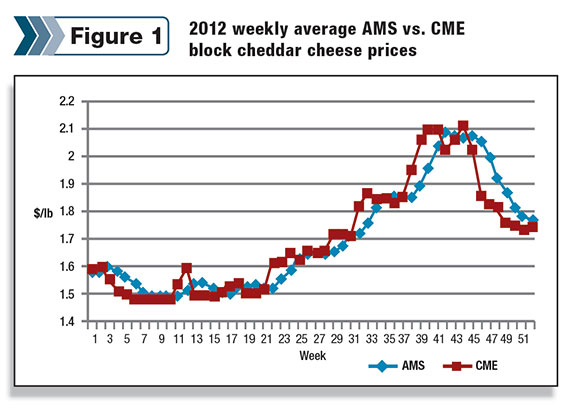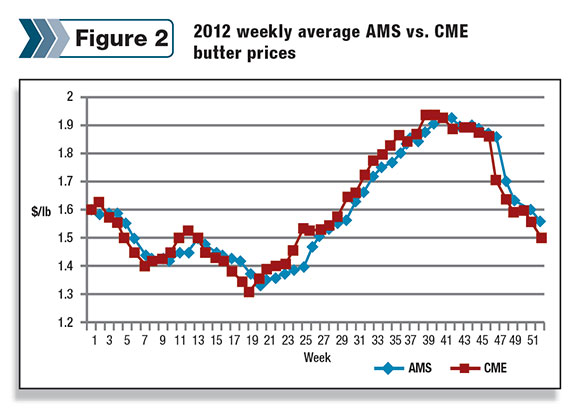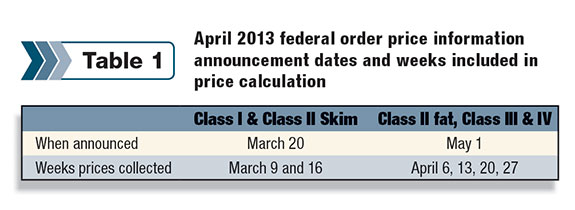A common question I receive is: What is the relationship between my milk price and dairy commodity prices trading on the Chicago Mercantile Exchange (CME)? In answering that question, let me begin by saying the California state order does use CME cheese and butter prices in determining a portion of that state’s milk prices. But federal milk marketing orders do not use CME prices.
However, there is a relationship between the cheese and butter prices used by federal orders and CME prices. Let’s look at that relationship to help dairy farmers better understand how CME prices impact their milk checks.
First, here’s some background information. The prices of butter, cheddar cheese (block and barrel) and dry whey are used to establish the federal order Class III price. Butter and nonfat dry milk powder prices determine the Class IV price.
The Class II price is set by the price of butter and nonfat dry milk powder, plus a $0.70-per-hundredweight differential. Formulas convert the prices of each of the dairy commodities into the respective class prices. The Class I price is a little more complicated.
Each month, the basis for the Class I price is calculated based on both butter and nonfat dry milk powder and on butter, cheese and dry whey. The one with the highest price is the Class I base price or mover.
The prices of the dairy products used by federal orders are collected and reported weekly by the USDA’s Agricultural Marketing Service (AMS) in the national dairy product sales report.
The Mandatory Price Reporting Act of 2010 provides the authority and outlines the procedures on how prices are collected and reported. AMS collects these prices from dairy manufacturing plants throughout the U.S.
For example, prices in the May 1, 2013, sales report were collected from 17 plants manufacturing 40-pound block cheddar cheese, 13 plants producing 500-pound cheddar barrels, 18 plants churning out butter, 29 plants drying milk into nonfat dry milk powder and 20 plants producing dry whey.
According to the 2010 act, the reporting plants must produce at least one million pounds of product, reported, each calendar year.

AMS collects the prices after Saturday of each week, and must report the prices by 3 p.m. Eastern time on Wednesday of the following week.
For example, prices for the week of March 24-30, 2013 were reported on Wednesday, April 3, 2013.
Relationship
Daily, the CME reports spot trading prices for cheese (block and barrel), butter and nonfat dry milk powder (two grades). The correlation between AMS and CME cheese and butter prices is strong (see Figures 1 and 2 ).

This is expected, in that most cheddar and butter sold in the U.S. is priced based on CME prices.
Using 2012 weekly average prices, the correlations between AMS and CME prices are $0.94 for both block and barrel cheddar cheese and $0.96 for butter.
In fact, the 2012 average of weekly prices for both AMS and CME block cheddar cheese price and butter is almost identical.
And the 2012 weekly average AMS barrel price was slightly higher than the CME price.
Looking closer at the figures, one can see when CME prices are increasing, AMS prices lag the CME price.
On the other hand, when CME prices are declining, AMS prices continue to lag CME prices and are higher than CME prices. Why the lag?
CME cheese and butter prices are daily spot prices, as mentioned earlier. They are the price a buyer is willing to pay and a seller is willing to sell a carload of cheese or butter on that particular day. Most U.S. cheddar cheese and butter manufacturers price their product based on CME prices.
Generally, a plant will price its product plus or minus so many cents above or below the CME price. Factors causing the variation from the exact CME price could include supply and demand, volume of product purchased, a regular customer versus a spot customer, time the product is held, freight considerations, etc.
In addition, the cheese or butter a plant sells today may not necessarily be priced based on today’s CME price. The plant may use the CME price on the day the product was made, not sold. The selling date may be a week or two weeks or more from the make date.
Or a plant may use CME weekly or monthly averages in pricing its product. These and other factors cause a lag between AMS and CME cheese and butter prices.
Timing

Another reason for the lag between AMS and CME cheese and butter prices is the time when federal order prices are announced and the time period the commodity prices used for the announced price are taken (see Table 1 ).
Federal orders do not announce prices for the four classes of milk at the same time. Class I and Class II skim prices are announced at one time each month, while Class II butter, Class III and Class IV prices are announced at another time.
Using the month of April 2013 as an example, federal order Class I and Class II skim prices were announced in the previous month on March 20. The April Class I price, announced on March 20, is based on commodity prices from the first two weeks of March.
Dairy farmers in high Class I utilization markets experience the greatest “lag” when prices are moving up. Likewise, when commodity prices are going down, high Class I markets experience the decline later.
For dairy farmers in manufacturing milk markets, the lag is not as great as the Class I market, but there is still a lag. Again using April 2013 as an example, Class III and IV prices were announced on May 1, but that price was based on commodity prices from the entire month of April.
There can be a large difference in prices from the first week compared to the last week. This is especially true in a month like April when CME prices advanced over $0.15 per pound from the beginning to the end of the month.
What about the other two commodities, nonfat dry milk powder and dry whey, which are used in federal order price calculations?
The CME trades daily in spot Grade A and extra grade nonfat dry milk powder. There is a positive correlation between these prices and the AMS prices but not as strong as cheese and butter.
This is due to less nonfat dry milk powder sold based on the CME price, compared to butter and cheese. The CME does not provide spot daily trading in dry whey, only dry whey futures.
Hopefully, this article has provided a better understand of the relationship between federal order prices and CME prices. The relationship between the two is strong.
When CME cheese and butter prices increase or decrease, those prices will eventually be reflected in the dairy farmer’s milk check. PD

-
Calvin Covington
- Retired Dairy Co-op Executive






